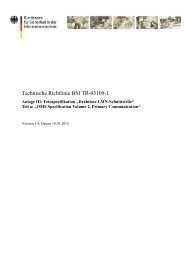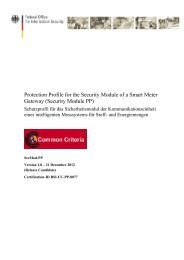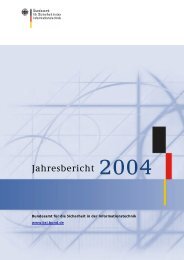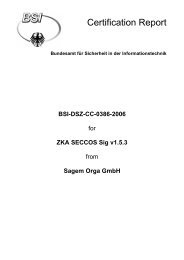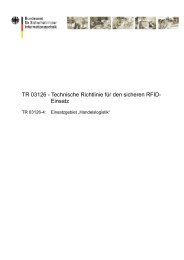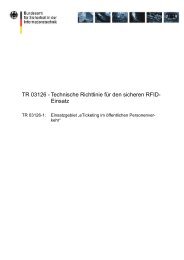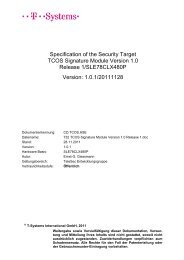Certification Report BSI-DSZ-CC-0769-2012 - Bundesamt für ...
Certification Report BSI-DSZ-CC-0769-2012 - Bundesamt für ...
Certification Report BSI-DSZ-CC-0769-2012 - Bundesamt für ...
You also want an ePaper? Increase the reach of your titles
YUMPU automatically turns print PDFs into web optimized ePapers that Google loves.
<strong>Certification</strong> <strong>Report</strong> <strong>BSI</strong>-<strong>DSZ</strong>-<strong>CC</strong>-<strong>0769</strong>-<strong>2012</strong><br />
Algorithm Bit<br />
Length<br />
ECDH 224,<br />
256,<br />
320,<br />
384,<br />
512,<br />
521<br />
AES 128,<br />
192,<br />
256<br />
Purpose Security Functionality Standard of<br />
Implementation<br />
Diffie-Hellman Keys<br />
for PACE, Terminal<br />
and Chip<br />
Authentication<br />
Symmetric<br />
Authentication<br />
Secure Messaging<br />
Authentication including<br />
cryptographic key generation<br />
– Diffie-Hellman for<br />
PACE, Terminal and Chip<br />
Authentication<br />
(FIA_API.1)<br />
Symmetric Authentication<br />
Secure Messaging with keys<br />
derived during PACE,<br />
Terminal and Chip<br />
Authentication resp.<br />
Symmetric Authentication<br />
(FIA_API.1,<br />
FTP_ITC.1/SVD,<br />
FTP_ITC.1/Conf_VAD,<br />
TP_ITC.1/Conf_DTBS)<br />
TR-03110 [20] [20]<br />
NIST 197 [21],<br />
EN 14890 [24]<br />
Table 3: Cryptographic Algorithms used by the TOE<br />
Standard of<br />
Usage<br />
[21], [24]<br />
The strength of the cryptographic algorithms was not rated in the course of this certification<br />
procedure (see <strong>BSI</strong>G Section 9, Para. 3, Clause 2).<br />
According to [25] the algorithms which are related to the explicit signature creation are<br />
suitable for the calculation of hash values and the creation of digital signatures. The<br />
validity period of each algorithm is mentioned in the official catalogue [25].<br />
According to [20] and [24] the algorithms which are related to PACE, to Terminal and Chip<br />
Authentication, to Symmetric Authentication as well as to Secure Messaging are suitable<br />
for authentication purposes and securing integrity, authenticity and confidentiality of data<br />
exchange and storage. For that reason an explicit validity period for these algorithms is not<br />
given.<br />
10 Obligations and Notes for the Usage of the TOE<br />
The documents as outlined in table 2 contain necessary information about the usage of the<br />
TOE and all security hints therein have to be considered. In addition all aspects of<br />
Assumptions, Threats and OSPs as outlined in the Security Target not covered by the TOE<br />
itself need to be fulfilled by the operational environment of the TOE.<br />
The customer or user of the product shall consider the results of the certification within his<br />
system risk management process. In order for the evolution of attack methods and<br />
techniques to be covered, he should define the period of time until a re-assessment for the<br />
TOE is required and thus requested from the sponsor of the certificate.<br />
The limited validity for the usage of cryptographic algorithms as outlined in chapter 9 has<br />
to be considered by the user and his system risk management process.<br />
11 Security Target<br />
For the purpose of publishing, the Security Target [7] of the Target of Evaluation (TOE) is<br />
provided within a separate document as Annex A of this report. It is a sanitised version of<br />
20 / 40


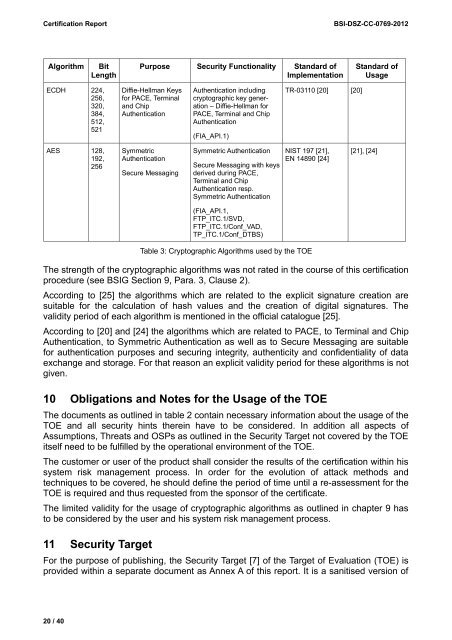
![[ST] System z10 EC LPAR Security Target V7.7.2 20081023 PU-205](https://img.yumpu.com/16227170/1/184x260/st-system-z10-ec-lpar-security-target-v772-20081023-pu-205.jpg?quality=85)

